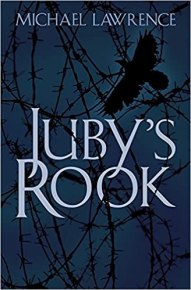For the #97 Sept 2009 issue of Writers’ Forum I interviewed children’s book writer Michaew Lawrence. Michael told me he does not like to specialise. His first book for children came out in 1995. Since then he has published around 50 more of various kinds, from first picture books to young adult novels.

His most popular books are the Jiggy McCue novels, which include The Killer Underpants, the Toilet of Doom, The Meanest Genie and The Iron, the Switch and the Broom Cupboard. He publishes one of these a year.

Michael explained he does not research the Jiggy McCue stories at all, or even attempt to reflect the times the kids live in to any great extent. Mobile phones, DVDs, famous film stars and so on are mentioned, but Jiggy and Co’s school experiences are essentially his own from over half a century ago. He bases their lessons on the lessons that he still remembers so well, and some of their teachers were his actual teachers he even uses their real names. You might think this would date the books, but Micheal said that children can’t have changed as much as we imagine, because a great many of them write to him to say the books are so much like their world.
Ideas for books often come to Michael in unexpected ways and often in unlikely places. Michael told me that one very wet Sunday in August 2008, he was in Tintagel, Cornwall, walking up the hill to the site of an Arthurian battle re-enactment, when the thought came that Jiggy’s parents might be visiting or taking part in just such a show and Jiggy is either whisked back in time or a knight from the past comes forward into his time. But almost at once he dismissed this as too obvious.
Plenty of bizarre things happen in Jiggy’s world, but time travel seemed unlikely to be one of them. But then he thought, suppose someone very like Jiggy lived in a century when men wore armour, fought with swords and jousted, and by the time he got to the re-enactment the spin-off series idea was born. It will be called Jiggy’s Genes, and each book is about an ancestor of Jiggy’s who bears not only the same nickname as him, but has similar attitudes, in spite of the time he is attached to.
He bought himself a hefty hardback Le Morte d’Arthur, a new copy of Roger Lancelyn Green’s King Arthur and His Knights of the Round Table (fondly remembered from childhood) plus various books and pamphlets about life and conditions in the 15th century and also trawled the Internet for alternative insights.
In the first book Jiggy’s Magic Balls, Thomas Malory has just escaped from gaol and has an idea for a saga about knights, great battles and quests. He asks for Jiggy’s help with ideas. The Arthur that Jiggy points out to Malory is a shifty little pickpocket, and Merlin is a shyster lawyer who specialises in divorce cases. Michael explained Malory uses their names but does something rather ambitious with their characters…
For the second book in the series,Jiggy and the Witchfinder, his 17th century hero meets Matthew Hopkins, the Witchfinder General, who wants to hang Jiggy’s Nan as a witch. Michael told me:
“Any Jiggy book must have a goodly quota of laughs, but the England of the period was beset by war, disease and poverty, and saw the execution of a great many innocent people at the hands of dreadful men like Hopkins, so it hasn’t been easy keeping the story light as well as realistic.” (Michael Lawrence)
Michael’s trilogy, The Aldous Lexicon (A Crack in the Line, Small Eternities and The Underwood See) and Juby’s Rook are all set in the ruined village of Rouklye, which is based on Tyneham in southern Dorset. He used his first house as the model for Withern Rise in Small Eternities: The Aldous Lexicon 2.

ML’s first house (model for Withern Rise in The Aldous Lexicon) (2)
“My research for the trilogy has been literally life-long, as the setting is the house and village I was born in. In the three years it took me to write the books I returned there constantly, and during the writing my desk was littered with photographs of the house, the stretch of river on whose bank it stands, and the village and attached market town.” (Michael Lawrence)
In 1943, Churchill’s War Office requisitioned the Tyneham Valley for troop training and weapons testing, evacuating everyone who lived there. They promised to return it when the war was over but never did, and today Tyneham. It is still ‘owned’ by The Ministry of Defence and is a sad, haunted ruin of a place. Juby’s Rook is set in 1999 and is about an elderly man (Juby Bench) who was a teenager in the village when everyone was turfed out.

He returns every August to take note of the extent of the decay and walk his old haunts. Michael has walked all of these haunts, during which, over several visits, he made extensive notes and took hundreds of photographs. Michael told me the completed book took about nine years to sell. If you haven’t heard of it, it’s because it sank without trace or a single review. Yet Juby’s Rook is one of the books he is most pleased to have got into print.
To read the complete feature you can purchase a copy of #97 Sept 2009 Writers’ Forum by ordering online from Select Magazines.
To read my latest Research Secrets or Writing 4 Children interviews you can invest in a subscription from the Writers’ Forum website or download Writers’ Forum to your iOS or Android device.














































